|
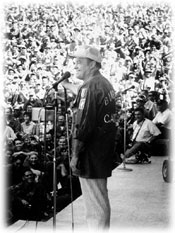 Prompted
by patriotism, and perhaps vaudevillian wanderlust, Bob Hope kept
touring for more than fifty years. Returning to his professional
roots, he took his variety show on the road to entertain U.S. troops
wherever those soldiers were stationed. Hope's variety shows for
the troops included comedy monologs, specialty acts, celebrity
appearances, dancers, singers, and skits. His mildly irreverent
humor, teamed with his variety troupe's beautiful women, provided
a welcome respite for the U.S. forces, a reminder, in Hope's words, "of
what they were fighting for." The fast pace, broad diversity, and
informality of the overseas shows, with acts ranging in tone from
brash to sentimental, gave U.S. fighting forces a supportive reminder
of home, an essence of American life and values. Prompted
by patriotism, and perhaps vaudevillian wanderlust, Bob Hope kept
touring for more than fifty years. Returning to his professional
roots, he took his variety show on the road to entertain U.S. troops
wherever those soldiers were stationed. Hope's variety shows for
the troops included comedy monologs, specialty acts, celebrity
appearances, dancers, singers, and skits. His mildly irreverent
humor, teamed with his variety troupe's beautiful women, provided
a welcome respite for the U.S. forces, a reminder, in Hope's words, "of
what they were fighting for." The fast pace, broad diversity, and
informality of the overseas shows, with acts ranging in tone from
brash to sentimental, gave U.S. fighting forces a supportive reminder
of home, an essence of American life and values.
|
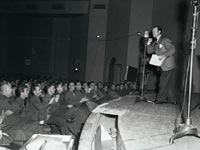
Radio broadcast, 1943.
Copyprint.
Bob Hope Collection,
Motion Picture, Broadcasting
and Recorded Sound Division (150)
|
World War II Radio Broadcast for Armed Forces During World
War II
Bob Hope began most of his radio broadcasts with the words, "This
is Bob [fill in name of remote location] Hope." Hope continued
to entertain U.S. troops, wherever they were stationed, for
fifty years. In 1997 Bob Hope was designated an honorary
veteran for his humanitarian services to the United States
Armed Forces by Congress. He is the only individual in history
to have earned this honor.
|
NBC Bob Hope Pepsodent Show Sponsor Card Showing
Remote Radio Broadcasts
Bob Hope's first radio show for the U.S. Armed Forces was
broadcast from March Field in Riverside, California. During
World War II Hope was sufficiently moved by the sacrifices
the U.S. troops made on behalf of the U.S. public that he
and his radio troupe traveled nearly every week to perform
The Pepsodent Show at a military training site. Of the 144
episodes of the radio program aired during the war, only
nine originated from NBC's studios.
|
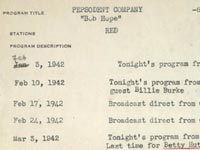
Sponsor card for Bob Hope's
Pepsodent Show,
February-June 1942.
NBC Collection,
Motion Picture, Broadcasting
and Recorded Sound Division (152)
|
|
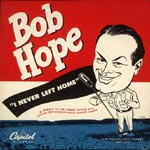
I Never Left Home,
June 1944.
78-rpm record album.
Bob Hope Collection,
Motion Picture, Broadcasting
and Recorded Sound Division (153)
|
I Never Left Home
In 1944 Bob Hope wrote a book, I Never Left Home, about
his work entertaining members of the armed forces during
World War II. Over 1.5 million copies of the book were sold.
It was adapted for radio for the Lux Radio Theater and
recorded as an album for Capitol Records.
|
First Overseas Visit to the Troops
Nine months after the United States's entered
World War II, Bob Hope made his first overseas trip to entertain
members of the armed forces. His travel to Alaska, then a
U.S. territory, required a special permit.
|
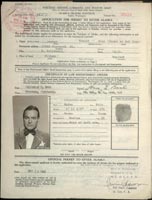
Application for Permit to Enter
Alaska, 1942.
Bob Hope Collection,
Motion Picture, Broadcasting
and
Recorded Sound Division (153A)
|
|
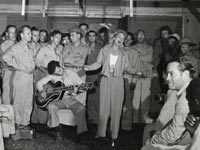
Guitarist Tony Romano accompanies
Frances Langford in an
impromptu performance,
1944.
Copyprint.
Bob Hope Collection,
Motion Picture, Broadcasting
and Recorded Sound Division (154a)
|
World War II photos of Bob Hope and Company
In the summer of 1944 Bob Hope hopped from island to island
in the South Pacific to entertain the troops. It was an emotional,
as well as dangerous, journey for Hope and his colleagues.
He logged over 30,000 miles and gave more than 150 performances.
Accompanying Hope on the trip were guitarist Tony Romano,
singer Frances Langford, dancer Patty Thomas, and gag-writer
and Hope chum, Barney Dean.
|
On the Road to Vietnam
This LP includes excerpts from Hope's monologs during his
1964 tour of Vietnam and Southeast Asia. The performers'
royalties from the sales of the disk were dedicated to the
United Service Organizations (U.S.O). The record received
only limited distribution.
|
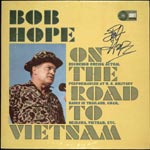
On the Road to Vietnam.
Chicago: Cadet Records, 1965.
Bob Hope Collection,
Motion Picture, Broadcasting
and Recorded Sound Division (156)
|
|
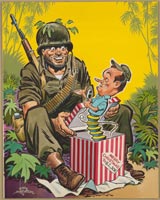
Carl Hubenthal.
Merry Christmas to GI Joe.
Oil painting, 1968.
Courtesy of Bob Hope Archives (156b)
|
Delivering "Home" for the Holidays
In December of 1948, Bob Hope and other performers
traveled to Berlin, Germany, to entertain members of the
armed forces participating in the Berlin Airlift. This was
his first Christmas tour to entertain troops and the beginning
of a Hope tradition that lasted until1990. Nine of Bob Hope's
Christmas tours included Vietnam, from 1964 until 1972.
|
Bob Hope in Vietnam
The U.S.O. established a tradition of sending Bob Hope on
tour to entertain members of the armed forces during the
Christmas holiday season.
|
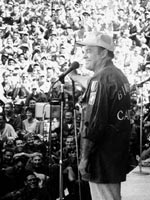
A Bob Hope U.S.O. show
in Vietnam, 1968.
Copyprint.
Bob Hope Collection,
Motion Picture, Broadcasting
and Recorded Sound Division (156a)
|
|
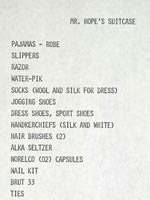
Bob Hope's Packing List for
a U.S.O. tour, 1969.
Typed manuscript.
Bob Hope Collection,
Motion Picture, Broadcasting
and Recorded Sound Division (157)
|
Bob Hope's Packing List, 1969
Bob Hope's life on the road continued well past the era
of vaudeville. Throughout his professional life, his commitment
to entertaining members of the armed forces and raising money
for charitable organizations kept him traveling, bringing
variety entertainment to millions. Hope traveled so frequently
that a list of travel necessities was prepared for use by
his staff.
|
"Around the World with the U.S.O."
The 1969 "Around the World with the U.S.O." tour was the
most ambitious of Hope's career, with performances in Germany,
Turkey, Thailand, Korea, and Vietnam. The first performance
of the tour was for President Richard M. Nixon and guests
at the White House.
|
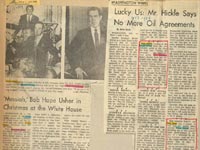
Hope scrapbook from
U.S.O. tour, 1969.
Page 2 - Page
3 - Page 4
Bob Hope Collection,
Motion Picture, Broadcasting
and Recorded Sound Division (158)
|
|
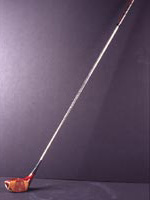
Golf club that Bob Hope carried
on stage during his 1969 U.S.O. tour.
Courtesy of Bob Hope Archives (160)
|
Bob Hope's Trademark Golf Club
Bob Hope never stopped being a vaudevillian. Throughout
his 1969 U.S.O. tour he carried on stage a symbol of his
life-long love for golf-a golf club-using it as a vaudeville
song-and-dance man would use a cane. This is the wood used
by Bob Hope on the 1969 World Tour.
|
Artillery Shell Mug
Throughout his career, Bob Hope has been methodical about
keeping records, objects, and memorabilia that document his
extensive career. Among the memorabilia in Hope's archive
is this mug made from a shell casing, given to him during
the 1969 U.S.O. tour. This item is one of thousands of such
handmade gifts given to Bob Hope by his admirers.
|

Mug made from an artillery
shell casing, 1969. Copper plate reads
"Mr. BH Code 124 From #88
TFW Korat RTAFB December 1969."
Courtesy Bob Hope Archives. (162)
|
|



